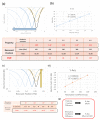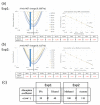Sensitivity Enhancement and Probiotic Detection of Microfluidic Chips Based on Terahertz Radiation Combined with Metamaterial Technology
- PMID: 35744518
- PMCID: PMC9228199
- DOI: 10.3390/mi13060904
Sensitivity Enhancement and Probiotic Detection of Microfluidic Chips Based on Terahertz Radiation Combined with Metamaterial Technology
Abstract
Terahertz (THz) radiation has attracted wide attention in recent years due to its non-destructive properties and ability to sense molecular structures. In applications combining terahertz radiation with metamaterial technology, the interaction between the terahertz radiation and the metamaterials causes resonance reactions; different analytes have different resonance performances in the frequency domain. In addition, a microfluidic system is able to provide low volume reagents for detection, reduce noise from the environment, and concentrate the sample on the detection area. Through simulation, a cruciform metamaterial pattern was designed; the proportion, periodicity, and width of the metamaterial were adjusted to improve the sensing capability of the chip. In the experiments, the sensing capabilities of Type A, B, and C chips were compared. The Type C chip had the most significant resonant effect; its maximum shift could be increased to 89 GHz. In the probiotic experiment, the cruciform chip could have a 0.72 GHz shift at a concentration of 0.025 mg/50 μL, confirming that terahertz radiation combined with a metamaterial microfluidic chip can perform low-concentration detection.
Keywords: metamaterials; microfluidics; probiotic; sensitivity enhancement; terahertz.
Conflict of interest statement
The authors declare no conflict of interest.
Figures











References
-
- Tonouchi M. Cutting-edge terahertz technology. Nat. Photonics. 2007;1:97–105. doi: 10.1038/nphoton.2007.3. - DOI
-
- Ren A., Zahid A., Fan D., Yang X., Imran M.A., Alomainy A., Abbasi Q.H. State-of-the-art in terahertz sensing for food and water security—A comprehensive review. Trends Food Sci. Technol. 2019;85:241–251. doi: 10.1016/j.tifs.2019.01.019. - DOI
Grants and funding
LinkOut - more resources
Full Text Sources

